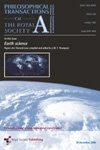 Physics, chemistry and physical chemistry have undergone tremendous changes over the course of this century. In physics, the focus has shifted from atoms to subatomic particles, namely nuclear physics and particle physics.
Physics, chemistry and physical chemistry have undergone tremendous changes over the course of this century. In physics, the focus has shifted from atoms to subatomic particles, namely nuclear physics and particle physics.It is rather fitting that to-day saw the "Guinness book of records" - successful start-up of the Worlds Biggest particle collider housed at CERN on or rather under the French-Swiss border. [cf. Footnote for a humours introduction peppered with serious links to CERN].
Meanwhile, the physics of collections of atoms in the liquid and solid states have slowly emerged as separate, independent fields.
After the Second World War, another interdisciplinary field emerged in the form of materials science, which combines metallurgy, physics, chemistry and physical chemistry. The goal of the subject is to synthesize materials such as metals, ceramics and polymers based on thermodynamic phase equilibria, reaction kinetics and our ability to characterize materials from the atomic level upwards. Particular attention is paid to the relationship between a material's microstructure and its bulk properties. Materials science also includes theoretical studies that deepen our understanding of the properties of materials, helping us to create new materials on a rational basis - rather than through trial and error alone.
Materials science can therefore be said to encompass all of the classical parts of science. (In fact an excellent example is given by the development and manufacture semi-conductors for the electronics industry. [my comment-JA]
Materials Technology & Engineering limits to Materials Science:
Early on, materials scientists and metallurgists tried to maximize a particular property, such as hardness, toughness, magnetization or conductivity. Great demands were made on developing materials with exceptional properties, such as ultimate strength. However, it soon became obvious that when it came to specific applications, advanced materials with various special properties were of little use unless they could be processed simply and straightforwardly. Thousands of materials have therefore been developed over the past 20 years - many with well defined and reproducible properties - but they have not been widely taken up by industry because they cost too much to make and are not particularly durable and may I add, classical engineering difficulties of scaling-up for many engineering applications. cf my previous post-on HKDH Bhadeshia "Big Chunks of Nano-Steel vs Carbon Nanotubes & Materials Modelling. The scale-up difficulty may also explain to some extent why materials scientists and the scientific community at large have massively moved to Richard Feynman's famous call: "There is plenty of room at the bottom". Here the materials scientist "does his own engineering -lab to lab at least in size and sometimes in terms of product volume or mass. But I am jumping the gun concerning Manfred Rühle's supportive conclusion!
Ball's response to critics is to underline the enormous progress achieved despite lack of adoption, or engineering deceptions (innovation from invention to market?). And bookmarks and describes 10 ten groups of materials that he thinks will be at the forefront of technology in the coming century.
Sources: Based on P. Ball's book published in 1997 reviewed in 1998.
(1) Made to Measure: New Materials for the 21st Century, by Philip Ball, 1997 Princeton University Press 480pp.
(2) Manfred Rühle reviewed P. Ball's book for physicsworld Manfred Rühle reviewed P. Ball's book for physicsworld, IOP-Inst. of Physics UK.
M. Rühle is director of the Max-Planck-Institut für Metallforschung, Stuttgart, Germany
2 Footnotes:
-The attentive reader and researcher may have noticed that Ball's book is based on guesses, all be they very educated ones, made from the 20 or so period before 1998?
The next century is now, but to be fair it may be sound practise to consider a full review at this half-way period current 2008? Opinions, Comments welcome.
-CERN add-on of 11 Sept. 2008.
I did not intend to add to the undoubtedly vast collection of news feed on this delicate operation by I could not resist linking readers to this humorous introduction by Aussie friends at AZOM (A to Z on Material) in their News Letter 77. [Link]
The Ultimate in "materials" research :LHC-Large Hadron Collider.
From the news papers:
Some say it's a toy some ask if it's as dangerous as it sounds such is the
energy and complexity of the technology and engineering involved
The Hopes, and The Fears
The experts were right: I did go-off well. Ouf!
Now it is up to the "powers that be" that this valuable and costly team do not do a "Challenger Space Flight" type disaster. Good luck and perhaps more importantly scientific, technological, engineering and last but not least "excellent management communication." (quoted from R. Feynman's report to Congress on the "Challenger Enquiry. - an industrial metallurgist, materials scientist and engineer remembers!)
The Metallurgy.(link)
The Technology and Engineering in pictures (link) and their prestigious origins in the 1960's.
HIGGS was found Yes indeed Higgs himself, one of the most renowned Scots' Theoretical Physicist of the day was invited to visit CERN and the LHC. It now remains to find the illusive particle,"Higgs Boson"
Disclaimer: I am unable to reference this very homorous introduction, to CERN's LHC for copyright reasons, and absence of a direct link to our Aussie friends Newsletter MyAZoM. Instead I shall give the reader a link to their well documented Materials Website AZoM.












No comments:
Post a Comment